
Meryta sinclairii, the puka or pukanui, is a large-leaved evergreen tree endemic to New Zealand that grows to about 8 m tall, with the distinctly tropical appearance typical of the genus. There are about 27 species of Meryta, all small, resinous trees of the subtropical and tropical Pacific Ocean.

Dracophyllum is a genus of plants belonging to the family Ericaceae, formerly Epacridaceae. There are 61 species in the genus, mostly shrubs, but also cushion plants and trees, found in New Zealand, Australia, Lord Howe Island and New Caledonia. The name Dracophyllum, meaning dragon-leaf, refers to their strong outward similarity to the unrelated Dracaena, sometimes known as dragon tree. Although dicotyledonous, they resemble primitive monocots with their slender leaves concentrated in clumps at the ends of the branches; they are sometimes called grass-trees.
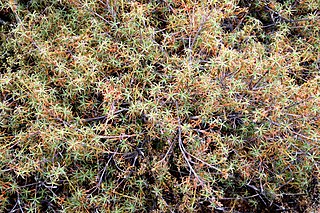
Dracophyllum recurvum, known commonly as curved leaf grass tree or neinei is a prostrate to semi-erect shrub belonging to the genus Dracophyllum.

Dracophyllum longifolium, commonly called inaka, is an upright shrub or small tree in the family Ericaceae that is endemic to New Zealand.

Dracophyllum arboreum, commonly known as Chatham Island grass tree and tarahinau (Moriori), is a species of tree in the heath family Ericaceae. Endemic to the Chatham Islands of New Zealand, it reaches a height of 18 m (60 ft) and has leaves that differ between the juvenile and adult forms.
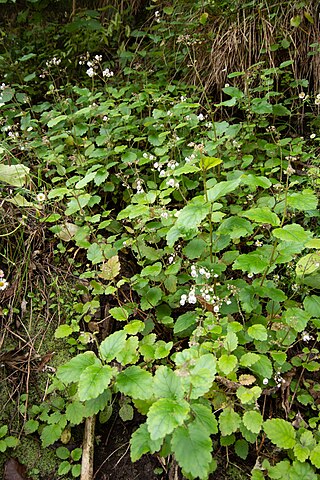
Jovellana sinclairii, commonly known as the New Zealand calceolaria, is an endemic New Zealand shrub found in eastern and central North Island forests. In the family Calceolariaceae, it has white, bell shaped flowers with spots of purple on the inside.
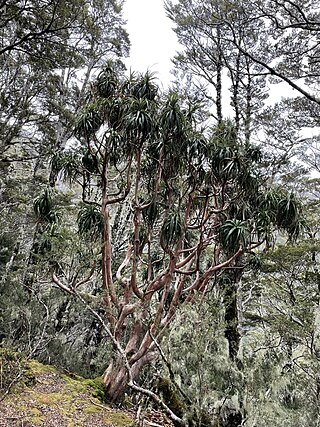
Dracophyllum traversii, commonly known as mountain neinei, grass tree, and pineapple tree is a species of flowering plant in the heath family Ericaceae. It is a deciduous tree endemic to New Zealand. It reaches a height of 0.2–13 m (0.66–42.65 ft) and has leaves which form tufts at the end of its branches. It has a lifespan of between 500 and 600 years.

Dracophyllum elegantissimum, commonly known as grass tree or slender dragon tree, is a flowering plant in the family Ericaceae. Endemic to New Zealand, it is found in the north of the South Island, in north-west Nelson.

Dracophyllum latifolium, commonly called needle-leaved neinei or spider wood, is a species of plant in the family Ericaceae. It is endemic to the North Island. It is a tall shrub or tree, 3–10 m tall.

Dracophyllum patens, commonly called Great Barrier Inaka, is a species of plant in the family Ericaceae that is endemic to New Zealand.

Dracophyllum menziesii, commonly known as pineapple scrub, is a species of shrub endemic to the South and Stewart Islands of New Zealand. In the heath family Ericaceae, it inhabits mountain slopes and cliffs from sea level up to 1,500 m (4,921 ft) and reaches a height of 0.5–1 m (1.6–3.3 ft). A 2017 assessment using the New Zealand Threat Classification System classified it as "Not Threatened", giving it an estimated population upwards of 100,000.
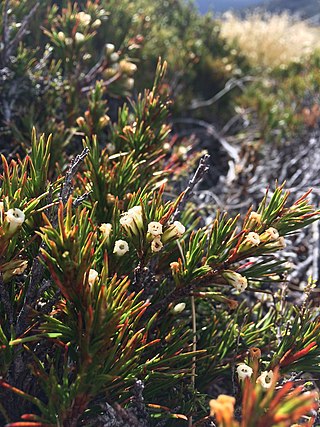
Dracophyllum rosmarinifolium, commonly known as inaka and common grass tree, is a species of shrub endemic to the North and South Islands of New Zealand. It was first described by Georg Forster in 1786 as Eparcris rosmarinifolium and gets the specific epithet rosmarinifolium for its similarities to species from the former genus Rosmarinus. In the heath family Ericaceae, it inhabits subalpine and montane gullies, cliffs, plateaux, valley floors and ridges, and reaches a height of 0.3–1 m (1.0–3.3 ft). A 2017 assessment using the New Zealand Threat Classification System classified it as "Not Threatened," giving it an estimated population of over 100,000.

Dracophyllum fiordense, commonly known as the Fiordland grass tree, is a species of tree or shrub in the heath family, Ericaceae. It is endemic to the South Island of New Zealand. It reaches a height of 1.5–5.0 metres and has tufts of long green leaves at the ends of its branches. Each leaf has a distinctive curled spiral tip. D. fiordense has a pyramid-shaped inflorescence hidden under each clump of leaves, with between 113 and 120 pink flowers on each spike, and later reddish-brown dry fruit; both are around just 2 by 2 mm. It inhabits shrubland, lowland and subalpine forests, and tussock grassland of mountain slopes, gullies, and ridges. Its range covers two main areas: one in Fiordland National Park, and one in the Mount Cook and Westland National Parks.
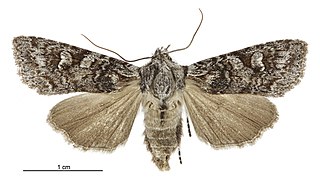
Physetica longstaffi is a species of moth of the family Noctuidae. It is endemic to New Zealand and found in the North and South Islands. This species lives in open habitats and shrublands, at altitudes ranging from the low alpine zone down to sea-level. As at 2017 the biology of this species is in need of further investigation as there is no published description of the larvae of this species nor have larval specimens been preserved in collections. There is also confusion over the possible larval host plants for this species. This species is on the wing from February to May. There is also a record from the North Cape in December. The adults of this species is attracted to light. P. longstaffi might possibly be confused with P. sequens or P. phricias. However unlike both P. sequens and P. phricias, P. longstaffi has a large oval mark near the centre of the forewing. Other distinguishing features include further differences in the colouration of the forewings of P. longstaffi as well as differences in the third labial palp segment of the male and differences in the shape of the male genitalia.

Dracophyllum kirkii is a species of shrub endemic to the South Island of New Zealand. It was first described by Sven Berggren in 1877 and gets the specific epithet kirkii after the New Zealand botanist Thomas Kirk. In the heath family Ericaceae, it inhabits mountain slopes and bluffs and reaches a height of just 20–140 cm (8–55 in). A 2017 assessment using the New Zealand Threat Classification System classified it as "Not Threatened", giving it an estimated population of more than 100,000.
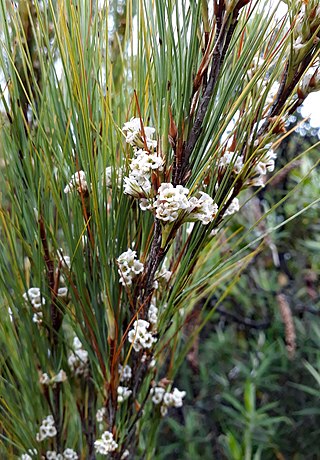
Dracophyllum filifolium is a species of shrub or tree endemic to the North, South, and Stewart Islands of New Zealand. It was first described by Joseph Dalton Hooker in 1853 and gets the specific epithet filifolium for its leaves being like a filament. In the heath family Ericaceae, it inhabits mountain slopes, saddles and ridges and reaches a height of 1–4 m (3–13 ft). A 2017 assessment using the New Zealand Threat Classification System classified it as "Not Threatened", giving it an estimated population of more than 100,000.
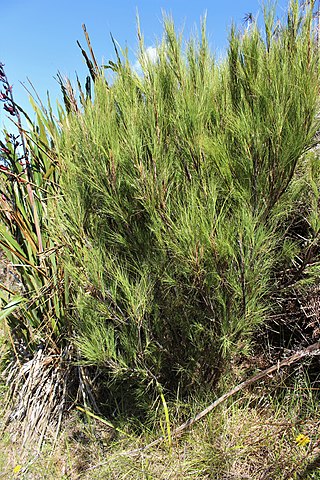
Dracophyllum acerosum is a species of shrub or small tree endemic to New Zealand's South Island. It was first described by Sven Berggren in 1877 and gets the specific epithet acerosum, meaning needles shaped, for its leaves. In the heath family Ericaceae, it inhabits mountain slopes, ridge lines and hillsides and reaches a height of 1–2 m (3–7 ft). A 2017 assessment using the New Zealand Threat Classification System classified it as "Not Threatened", giving it an estimated population of more than 100,000.
Dracophyllum lessonianum, commonly known as the gumland grass tree, is a species of tree or shrub in the heath family Ericaceae. It is endemic to the North Island of New Zealand. D. lessonianum was first described by the French botanist Achille Richard in 1832.

Dracophyllum subulatum, commonly known as monoao, is a species of tree or shrub in the heath family Ericaceae. It is endemic to the central North Island of New Zealand.

















